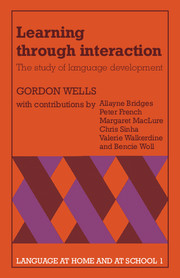Book contents
- Frontmatter
- Contents
- Acknowledgments
- Introduction
- 1 Language as interaction
- 2 Becoming a communicator
- 3 The development of comprehension
- 4 Context, meaning and strategy in parent–child conversation
- 5 Developing linguistic strategies in young school children
- 6 A comparison of talk at home and at school
- 7 Language, literacy and education
- Appendix Bristol language development study: transcripts
- References
- Index
2 - Becoming a communicator
Published online by Cambridge University Press: 05 June 2012
- Frontmatter
- Contents
- Acknowledgments
- Introduction
- 1 Language as interaction
- 2 Becoming a communicator
- 3 The development of comprehension
- 4 Context, meaning and strategy in parent–child conversation
- 5 Developing linguistic strategies in young school children
- 6 A comparison of talk at home and at school
- 7 Language, literacy and education
- Appendix Bristol language development study: transcripts
- References
- Index
Summary
What the child can do today in co-operation, tomorrow he will be able to do on his own.
(Vygotsky, 1962)In the first chapter we considered in broad outline what is involved in linguistic interaction. As we saw, successful communication is a collaborative enterprise, in which each participant in his turn as speaker constructs and encodes his message so that it both adequately conveys his intention and also orients to the informational needs and expectations of the hearer at that point in the conversation. At the same time, the hearer plays his part by drawing upon a variety of sources of information in the situation and his past experience in order to interpret and fill out the message that he decodes from the actual speech signal. In performing these tasks, both speaker and hearer engage in a number of interrelated processes: translating between personal experience and the semantic structure of their common language; encoding and decoding meaning intentions through lexical items in grammatical structures; and integrating the phonological, prosodic and gestural patterns by means of which the message is given physical realisation. These are the processes that the language learner has to master, and in this chapter we shall consider how the young child sets about this task.
Attempts to explain the development of language, however, are closely tied to the beliefs that are held about the nature of language itself and about the way in which it should be studied.
- Type
- Chapter
- Information
- Learning through InteractionThe Study of Language Development, pp. 73 - 115Publisher: Cambridge University PressPrint publication year: 1981
- 3
- Cited by



